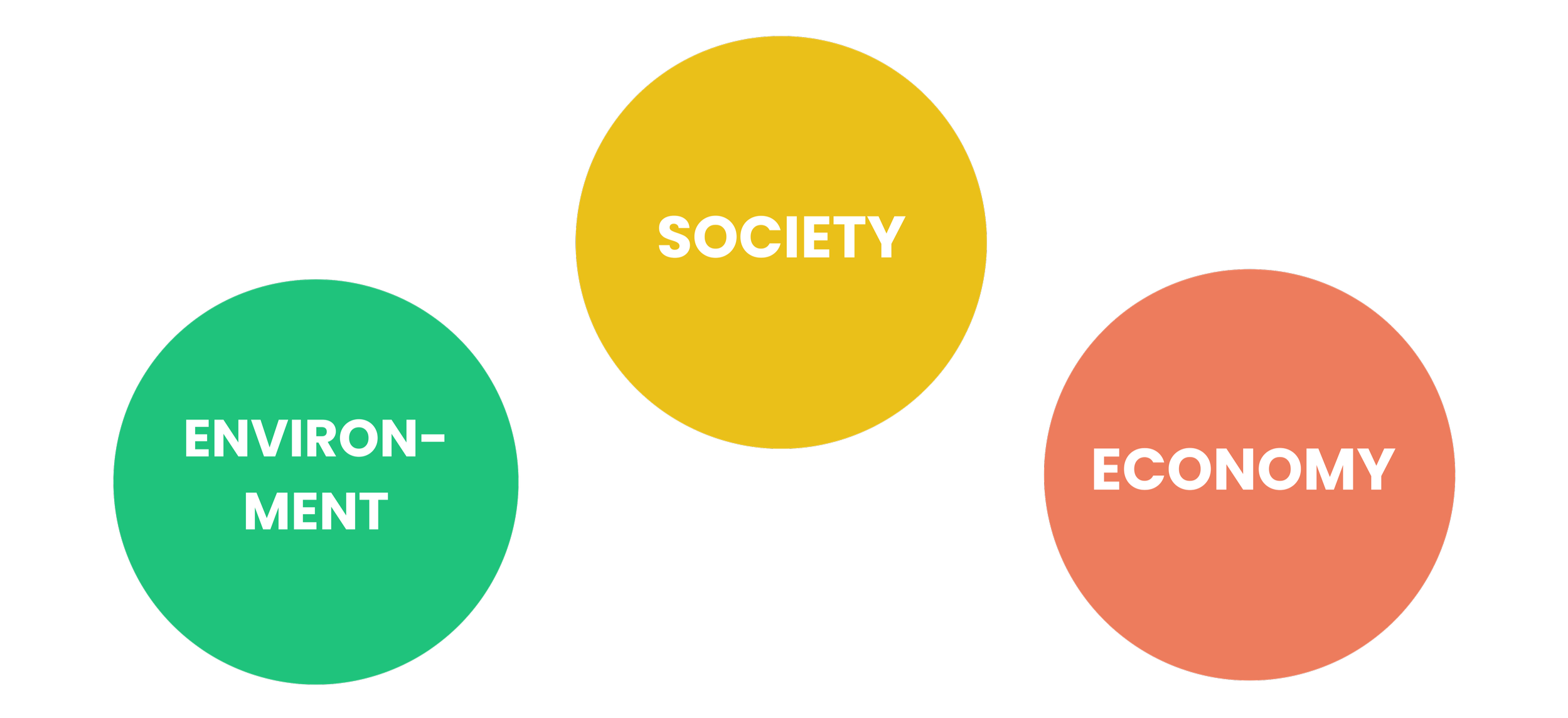Lessons from School Sustainability Leaders
Transform the Understanding of Sustainability
Sustainability is not just an ‘environmental thing’
Sustainability isn’t just about the environment – it includes economic, social and environmental pillars, and if one pillar is weak, the whole system is unsustainable. By avoiding a narrow focus on the environmental pillar, you can pull a lot more people into the conversation and demonstrate the far-reaching importance of sustainability.
If we look at the past 200 years — our law, industries, and even our education systems — which have treated as the most important: the environment, society, or the economy?
Most of us would agree that we almost always prioritize the economy. We’ve measured progress in GDP, defined success by material wealth, and often put environmental and social concerns last. And we tend to treat these as separate issues.
But sustainability asks us to rebalance this — to see these as interconnected. To see a healthy environment as the foundation.
Our economy depends on natural resources, food systems, and stable supply chains.
Our society depends on clean water, good health, safety, and strong communities. All of these rely on a healthy, living planet.
One key take away is this:
Sustainability is not just an environmental thing. It is the harmony of our economy and society with our environment.
The choices we make today will determine whether current and future generations can live safely, free from the growing risks of environmental disasters. It’s about ensuring access to clean water, healthy food, stable communities, and the natural resources needed to thrive. When schools embrace sustainability, they’re not just protecting the planet—they’re safeguarding the wellbeing and opportunities of the students in their care, and of the generations still to come.
Beyond the Environment: The Wider Benefits of School Sustainability
When schools commit to sustainability, the rewards extend far beyond reducing environmental impact. These efforts strengthen school culture, improve student learning, support health and wellbeing, and even cut operational costs. In other words, sustainability is not only about protecting the planet—it’s also about creating stronger, healthier, and more resilient school communities.
Cost Effectiveness
Green schools aren’t just good for the planet—they’re smart investments. A review of 30 green schools found they saved up to four times the cost of going green, through energy savings, efficiency, and lower operational costs.
Health and Performance
Sustainable schools improve indoor and outdoor air quality, which supports cognitive function and reduces the frequency and severity of asthma. Green cleaning and pesticide reduction policies help protect students and staff from exposure to potentially harmful chemicals, including endocrine-disrupting and carcinogenic compounds. Access to green space and nature has been shown to improve mental health and even academic performance.
Studies of young people aged 16–25 years old shows that 60% reported being very or extremely worried about climate change, and more than three quarters find the future frightening. However, a comprehensive review of schools in the UK found that: “Pessimism turned to hope when [students] felt that they had the power to act… the children who were most confident that climate change need not overwhelm them were those whose schools had decided to replace unfocused fear by factual information and practical strategies for energy reduction and sustainability”.
Student Empowerment
Education equips students with the skills, knowledge, and mindset to tackle real-world challenges with creativity and confidence. Schools play a vital role in helping young people understand complex issues—like how to protect and regenerate natural resources, manage risks, and strengthen community resilience. Students exposed to environmental education show improved academic performance, especially in science and reading.
Future-Proofing
Embracing sustainability can help to future-proof our school. As the world increasingly prioritizes sustainability and climate action, schools that take proactive steps will be better positioned to adapt, lead, and stand out in a competitive education landscape. Research shows that green schools enjoy a 72% improved community image, and surveys consistently find that Millennials and Gen Xers prefer to work for institutions with clear sustainability or climate policies. In a time when attracting and retaining great teachers is more important than ever, sustainability can be a compelling differentiator.
Leadership in Building a Healthy, Sustainable Future
Sustainable schools show their communities that they’re preparing for the future. They’re even showing their communities how to do it. As laboratories of learning, schools can spur paradigm shifts, leadership, problem-solving and innovation to build a healthier and sustainable future, in which people and planet can thrive.

Sustainability:
“Meeting our own needs without compromising the ability of future generations to meet their own needs.”
One way to understand it is like a bank account. The way humans are living and treating the planet - we are taking money out of the bank account - taking, taking and taking, without putting money back in. If we keep going this way, one day the account will be empty, or worse, in debt!
How we live today will impact the health of the planet for us, and for all generations to come.
What kind of world do we want to pass on to today’s children, and their children?
And are we equipping today’s students to become problem-solvers, innovators, and creators of a sustainable future—or leaving them to face it unprepared?
💡 Tips for Communicating Effectively about School Sustainability:
Start with shared values. Connect sustainability to what your school already cares about—student success, wellbeing, cost savings, safety, and community pride.
Use clear examples. Highlight non-environmental benefits in action, like how efficient lighting saves money for new resources, or how greener grounds improve student health and focus.
Bring in student voices. Let students share why sustainability matters to them; their perspectives are powerful for shifting mindsets.
It’s an opportunity, and a responsibility. Show colleagues and leaders how sustainability creates new learning experiences, leadership pathways, and community connections.
Keep it visible. Celebrate wins publicly—post updates on notice boards, in newsletters, or at assemblies—so sustainability is seen as part of everyday school life.
“Show how sustainability ‘scratches their itch”










